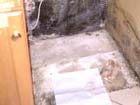
Should you throw away furniture that has been contaminated by mold or can moldy furniture be saved? Deciding what to do with mold-infested furniture is not always a straightforward decision but whichever course of action you decide to take will depend on various factors. For you to undertake mold remediation on wood, the mold needs to be visible. Your decision may also depend on whether primary or secondary contamination has taken place.
Primary contamination takes place when a piece of furniture directly facilitates mold growth given the moisture level of the furniture. For example, a wet seat or a piece of furniture that absorbs water following floods or leakages in the building is directly supporting mold growth. Secondary contamination occurs when a piece of furniture is close to other items that are mold infested or is placed in a mold-infested area. Even though the piece of furniture is not directly supporting mold formation, it can easily become contaminated due to proximity.
What To Do About Primary Contamination
It is advisable to throw away furniture that succumbs to primary contamination, more so if the piece of furniture absorbs a lot of water. In case you catch the mold growth early, you might not have to throw the furniture as the growth could just be on the surface.
How to clean mold off wood furniture?
In this case, simply use a mold removal soup and bleach to clean the piece of furniture outdoors. To eliminate the mold stains, sand down the furniture and apply a clear vanish that will keep the wood from absorbing additional moisture.
If the piece of furniture is directly supporting mold growth and the growth is extensive, it may not be feasible to remove the mold on your own as it is likely to grow back. If the item is not valuable, get rid of it. If it is valuable, it could be time to hire the services of a mold removal and restoration contractor.
Solutions for Secondary Contamination
In the case of secondary contamination, mold treatment is not always necessary and when it is, it is easy to undertake. Essentially, mold spores are airborne and they can be found just about anywhere. This means that furniture and items will always have a certain amount of secondary contamination or surface mold. Generally, you can use water and detergent to clean surface mold on furniture. To avoid overgrowth of mold, it is best to find the source of moisture and to find ways of keeping the building dry.
Removing Airborne Spores
To eliminate airborne mold spores and to clean up surface molds on furniture, you can simply ventilate the rooms. Alternatively, use air cleaners to lower the level of airborne spores. The best thing about abating secondary molds is that you do not have to move the furniture somewhere else. After scrubbing and wiping down the mold, be sure to dry the furniture surface with a high efficiency particulate air vacuum.
The most important aspect about eliminating mold from lumber is identifying and eliminating the source of moisture. Even if you remove mold growth in the building and on the furniture, the mold is likely to grow back if the conditions are suitable.


